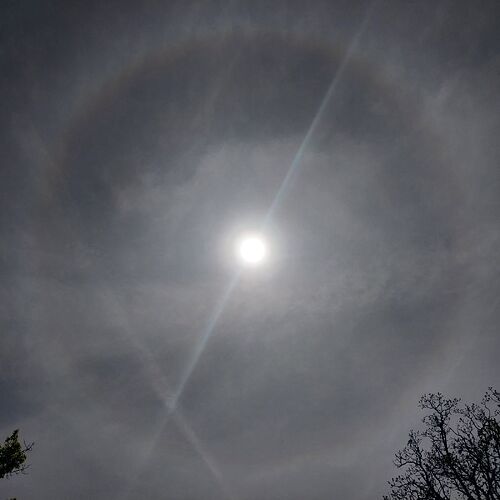Mosaic showing the stages of the total eclipse from just outside of Poplar Bluff, Missouri.
Andy,
Thanks for the kind words. I have to agree, it is a little weird seeing multiple near-simultaneous images of the same celestial event, but I find it quite interesting to see the variety of methods and results.
Andy,
Fantastic mosaic. It captures the whole event from partial phases through the diamond rings, the corona, and Bailey’s beads. I especially like how you’ve depicted Bailey’s beads, showing their development in time sequence. Also, very nice job capturing all the prominence activity around the entire solar limb. Well done!
2024 Total Solar Eclipse. Composition to reveal the structure of the inner “flower petals” and outer “streamers” of the Sun’s Corona during the total eclipse.
ASI2600mc
ASTRO-TECH AT65EDQ
420mm focal length, 1.5x crop factor of Aps-C sensor.
Sky-Watcher EQ6-R Pro mount
Pixinsignt and Photoshop.
4/8/24 Poplar Buff, Missouri
Wow!
Well, this wasn’t taken by a club member, and isn’t of the most recent total solar eclipse, but I thought it was pretty cool.
The earliest scientifically useful photograph of a total solar eclipse was made by Julius Berkowski at the Royal Observatory in Königsberg, Prussia, on July 28, 1851. This was the first occasion that an accurate photographic image of a solar eclipse was recorded.

Pretty good for 1851. I wonder how long his post processing took?
I looks pretty much like what we saw, for real that’s pretty accurate. He even got to see filaments like we did.
Andy’s excellent animation of Baily’s Beads (above) shows them in the Sun’s upper left quadrant at the beginning of totality, so I put together this animation of the Beads in the Sun’s lower right quadrant just as totality was ending. Also shown are some eruptive prominences and the diamond ring effect.
Equipment: Orion ST-80 (80 mm f/5) telescope; Orion Solar Filter; Orion Field Flattener; Baader Fringe Killer Filter; ZWO ASI482MC camera.
Top-Notch Russ!!! It was amazing, I can’t stop thinking how the filaments were naked eye visible!
Yes, that big triangular sharped one at the bottom was easily visible to the bare eyeball. It was an impressive sight!
I did a video of the the eclipse from Keller Texas. My son nixed my first time lapse video attempt – he said I have crummy taste in music. But he did like this “poster” picture:
 2024_Solar_Eclipse by chris varner, on Flickr
2024_Solar_Eclipse by chris varner, on Flickr
Looks great! Well done Chris ![]()
![]()
![]()
Chris,
I can’t comment on the video as I haven’t seen it or heard its accompanying music. But, I agree with your son about this poster. Very nicely done sequence.
Nice Halo! It looks like it has a diffraction spike. I’m not sure if it is due to serendipity or just great travel planning, but it sure is cool.
Definitely serendipity!
We could see the shadow traveling across the clouds and they were thin enough to allow the halo. Simple cell phone shot.
After a number of false starts, here is the video of my Solar Eclipse adventure in Fort Worth.
 2024 Solar Eclipse From Texas by chris varner, on Flickr
2024 Solar Eclipse From Texas by chris varner, on Flickr
@mpsurge Your eclipse shots are very nice, but I think I like the shot through the trees better! There’s something about that one that makes it stand out.
@CatsPaw Nice compilation video!








